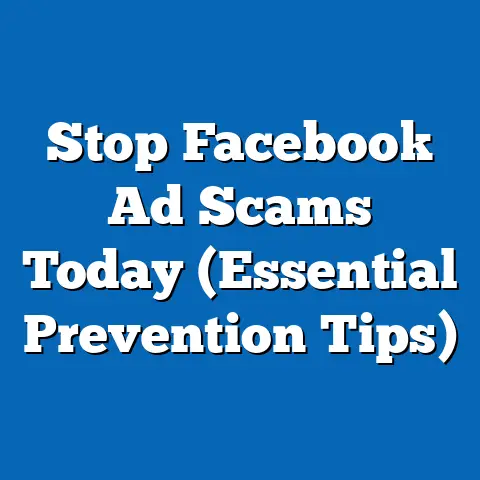Easily Remove Unwanted Facebook Accounts (Expert Guide)
As of 2023, Facebook boasts over 2.9 billion monthly active users. While this vast network connects people globally, it also presents a challenge: the presence of duplicate or fake accounts. A staggering 5% of accounts are reported as such, highlighting the necessity for users to manage their online presence effectively. I’ve seen firsthand how these unwanted accounts can create confusion, compromise privacy, and even lead to security risks. That’s why I’m here to guide you through the process of removing them, step-by-step.
Unwanted Facebook accounts can pose significant risks to your personal security, data privacy, and overall online reputation. They can be used for impersonation, spreading misinformation, or even phishing attacks. Leaving these accounts active is like leaving your digital door unlocked. In this guide, I’ll walk you through everything you need to know to identify, remove, and prevent unwanted Facebook accounts, ensuring a cleaner and safer online experience. Consider this your expert playbook for taking control of your Facebook presence.
Understanding Unwanted Facebook Accounts
So, what exactly constitutes an “unwanted” Facebook account? Let’s break it down.
- Fake Profiles: These are accounts created with the intent to deceive. They might use stolen photos, fabricated information, or even impersonate real people. I once helped a friend who discovered a fake profile using her photos to scam people out of money. It was a nightmare, but we got it taken down.
- Abandoned Accounts: These are accounts that users have simply stopped using, often because they’ve forgotten the login details or no longer want to be on Facebook. They can still be accessible if someone manages to guess the password.
- Duplicate Accounts: Some people unintentionally create multiple accounts, perhaps forgetting they already have one. These can create confusion and dilute your online presence.
There are several reasons why you might encounter these unwanted accounts:
- Data Breaches: Cybercriminals sometimes create fake profiles using information leaked from data breaches. This is why it’s crucial to use strong, unique passwords for all your online accounts.
- Impersonation: As mentioned earlier, someone might create a profile pretending to be you or someone you know.
- Forgotten Credentials: It’s surprisingly common for people to forget their Facebook login details, leading to abandoned accounts that are still technically active.
Leaving these unwanted accounts active can be dangerous:
- Identity Theft: A fake profile impersonating you could damage your reputation or even be used to commit fraud.
- Phishing Attacks: Fake profiles can be used to trick you into clicking malicious links or providing personal information.
- Spread of Misinformation: Fake accounts often amplify the spread of fake news and propaganda.
Takeaway: Understanding the types and dangers of unwanted Facebook accounts is the first step in protecting your online presence.
Identifying Unwanted Accounts
Now that we know what to look for, let’s dive into how to identify these unwanted accounts.
- Reviewing Friend Lists: Carefully go through your friend list. Do you recognize everyone? Are there profiles with very few friends or generic profile pictures? These could be red flags. I make it a habit to review my friend list every few months. It’s surprising how many inactive or suspicious profiles I find.
- Checking for Duplicate Accounts: If you suspect you have a duplicate account, search for your name on Facebook. If you find another profile that looks like yours, report it to Facebook.
- Recognizing Signs of Impersonation: Impersonation profiles often have subtle differences from the real one. Look for variations in the profile picture, missing information, or unusual posts. If you suspect someone is impersonating you, report it immediately.
- Verifying Account Legitimacy: Check the profile’s history. How long has the account been active? Are there consistent posts and interactions? A recently created account with little activity could be suspicious.
Here are some additional tips:
- Reverse Image Search: If you’re suspicious of a profile picture, use Google’s reverse image search to see if the image has been used elsewhere.
- Check for Unusual Behavior: Does the account frequently send spam messages or post suspicious links? This is a strong indicator of a fake profile.
- Trust Your Gut: If something feels off about an account, it’s better to be safe than sorry. Report it to Facebook.
Takeaway: Regularly reviewing your friend list and being vigilant about suspicious profiles can help you identify unwanted accounts before they cause problems.
Step 1: Logging into Facebook
This might seem obvious, but it’s the crucial first step.
- Desktop: Open your web browser and go to www.facebook.com. Enter your email or phone number and password, then click “Log In.”
- Mobile (App): Open the Facebook app on your smartphone or tablet. Enter your email or phone number and password, then tap “Log In.”
If you’ve forgotten your password, click the “Forgotten password?” link and follow the instructions to reset it.
Step 2: Navigating to Account Settings
Once you’re logged in, you need to find your account settings.
- Desktop: Click the downward-facing arrow in the top-right corner of the screen and select “Settings & Privacy,” then “Settings.”
- Mobile (App): Tap the three horizontal lines (menu icon) in the top-right (Android) or bottom-right (iOS) corner. Scroll down and tap “Settings & Privacy,” then “Settings.”
Step 3: Finding Account Removal Options
Now, let’s find the account removal options. This is where it can get a little tricky, as Facebook sometimes changes the location of these settings.
- Desktop: In the left-hand menu, click on “Your Facebook Information.” Then, look for “Deactivation and Deletion” and click “View.”
- Mobile (App): Scroll down to “Your Facebook Information” and tap on it. Then, tap on “Deactivation and Deletion.”
Step 4: Choosing Between Deactivation and Deletion
This is a critical decision. Let’s understand the difference:
- Deactivation: This is a temporary suspension of your account. Your profile will be hidden from other users, and you won’t be able to use Facebook. However, your information is still stored, and you can reactivate your account at any time by logging back in. I’ve deactivated my account a few times when I needed a break from social media. It’s a good option if you’re not sure you want to leave Facebook permanently.
- Deletion: This is a permanent removal of your account. All your photos, videos, posts, and other information will be permanently deleted from Facebook’s servers. You won’t be able to reactivate your account, and you’ll lose access to any apps or websites that use Facebook Login.
Choose carefully! If you’re unsure, I recommend deactivating your account first. You can always delete it later.
Step 5: Confirming the Removal
Once you’ve chosen between deactivation and deletion, you’ll need to confirm your decision.
- Deactivation: Facebook will ask you why you’re deactivating your account. You can select a reason or choose “I have another reason.” Then, click “Deactivate.” You’ll be prompted to enter your password to confirm.
- Deletion: Facebook will warn you about the consequences of deleting your account and provide options to download your information. Review these options carefully. Then, click “Delete Account.” You’ll be prompted to enter your password to confirm.
Step 6: Finalizing the Process
After confirming your decision, the process will begin.
- Deactivation: Your account will be immediately deactivated.
- Deletion: Facebook will initiate the deletion process, which can take up to 90 days to fully complete. During this time, your account will be inaccessible to other users.
Important Note: Even after the 90-day deletion period, some of your information, such as messages you sent to other users, may still be visible to them.
Takeaway: Carefully follow these steps to remove unwanted Facebook accounts, ensuring you understand the difference between deactivation and deletion.
Common Issues and Troubleshooting
Even with the best instructions, you might encounter some issues during the account removal process. Let’s address some common problems and how to solve them.
- Forgotten Password: If you’ve forgotten your password, click the “Forgotten password?” link on the login page and follow the instructions to reset it. You’ll likely need to provide your email address or phone number associated with the account.
- Difficulty Verifying Identity: Facebook might ask you to verify your identity by uploading a photo ID. Make sure the ID is clear and matches the name on your account.
- Unauthorized Account Removal: If you believe your account was removed without your permission, contact Facebook support immediately. They can investigate the issue and help you recover your account.
- Appealing Against Unauthorized Accounts: If you find an unauthorized account impersonating you, report it to Facebook. Provide as much information as possible, including screenshots and details about the impersonation.
- Recovering Mistakenly Flagged Accounts: If your account was mistakenly flagged and suspended, you can appeal the decision to Facebook. Explain the situation and provide any relevant information that supports your case.
Here are some expert solutions for these problems:
- Use a Password Manager: A password manager can help you keep track of your passwords and generate strong, unique passwords for all your online accounts.
- Enable Two-Factor Authentication: Two-factor authentication adds an extra layer of security to your account, making it more difficult for hackers to access.
- Keep Your Contact Information Up-to-Date: Make sure your email address and phone number are current so you can easily reset your password if needed.
- Contact Facebook Support: If you’re facing persistent issues, don’t hesitate to contact Facebook support for assistance.
Takeaway: Knowing how to troubleshoot common issues can save you time and frustration during the account removal process.
The Importance of Regular Account Maintenance
Removing unwanted accounts is a great start, but it’s not a one-time fix. Regular account maintenance is crucial for maintaining your online security and privacy.
- Periodic Checks for Unwanted Accounts: Make it a habit to review your friend list and search for suspicious profiles every few months.
- Staying Informed About Privacy Settings: Facebook’s privacy settings are constantly evolving. Stay informed about the latest changes and adjust your settings accordingly to protect your information. I make it a point to review Facebook’s privacy policy updates at least once a year.
- Reviewing App Permissions: Regularly review the apps that have access to your Facebook account. Revoke permissions for any apps you no longer use or trust.
- Reporting Suspicious Activity: If you notice any suspicious activity on Facebook, such as spam messages or unusual posts, report it immediately.
- Being Mindful of What You Share: Be careful about the information you share on Facebook. Avoid posting sensitive details that could be used for identity theft or other malicious purposes.
Here are some additional tips:
- Use a VPN: A VPN can help protect your privacy by encrypting your internet traffic and masking your IP address.
- Be Wary of Phishing Scams: Be cautious of emails or messages that ask you to provide personal information or click on suspicious links.
- Educate Yourself: Stay informed about the latest online security threats and best practices.
Takeaway: Regular account maintenance is essential for protecting your online security and privacy on Facebook.
Conclusion
Removing unwanted Facebook accounts is a vital step in safeguarding your personal safety and managing your online reputation. By following the steps outlined in this guide, you can effectively identify, remove, and prevent these accounts, ensuring a cleaner and safer Facebook experience. Remember, your online presence is an extension of yourself, and taking control of it is essential in today’s digital age. I hope this guide has empowered you to take action and create a more secure and enjoyable Facebook experience. Now go forth and conquer those unwanted accounts!






